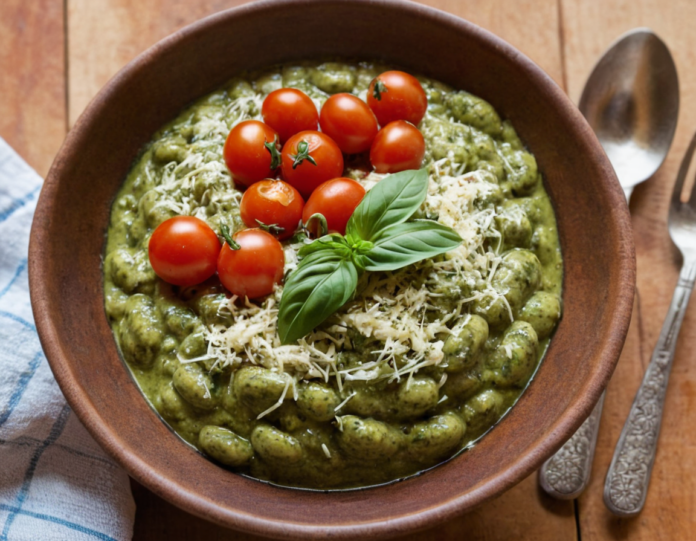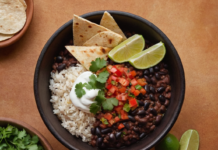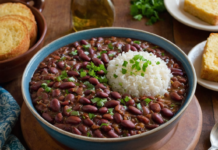Pesto beans take the creamy texture of beans with the rich herbaceousness of pesto, resulting in a dish that is as delicious as it is nutritious. Whether accompanied by broth or served as a side or even a main dish, this recipe is flexible and straightforward to make. You need to put the proper techniques together with some fresh ingredients to get a balanced and tasty meal.
For Pesto Beans, Picking the Right Beans
Choosing the right kind of beans is important and will help you get the taste and consistency of pesto beans that you want. Different beans will interact differently with the pesto, which in turn would influence the overall texture of the final dish.
The best options are white beans, like cannellini or great northern beans. They have a mild flavor and creamy texture that absorbs pesto well, creating a smooth, rich consistency. The chickpeas are firmer but contribute a subtle nutty flavor that works when mixed with pesto.
Using a blend of beans is also a good option if you like a more complex texture. Using both white beans and chickpeas makes for a textural contrast between creaminess and firmness, making it delicious with every bite. We need the right balance, as too firm of a bean can lead to a dry dish.
Rinsing canned beans well will eliminate excess sodium and prevent an overpowering salty taste for those using canned beans. But with dried beans, an overnight soak and proper cooking bring out their natural flavor and ensure they blend nicely with the pesto.
Essential Components in an Authentic Pesto Beans Recipe
A good pesto beans dish depends on good ingredients. This will improve both the taste of your food and its nutritional value.
The main ingredients are:
- Sweet basil is the standard bearer of pesto’s aroma and flavor.
- Garlic, for its savoriness and spicy nuance.
- Pine nuts for a subtle nuttiness, though walnuts or almonds can work as a substitute.
- Parmesan cheese, which adds a deep umami taste.
- Extra virgin olive oil
- Essential for a smooth, well-blended pesto.
- Lemon juice makes everything taste brighter and cuts the fat.
- Salt and black pepper for overall seasoning.
- White beans, chickpeas, or a mix of both, according to the texture you want
These are all wonderful ingredients to use; they allow the use of fresh and vibrant flavors in the dish, making it healthy as well.
A Step-by-Step Guide to Pesto Beans
Preparing the Pesto
Wash basil leaves (fresh or dried) to eliminate excess water. Then, in a food processor, blend basil, garlic, and nuts until finely chopped. While blending, slowly add olive oil until smooth.
Incorporate grated Parmesan and freshly squeezed lemon juice, then season with salt and pepper.
Cooking the Beans
If using dried beans, soak them overnight, then boil until tender. Drain and rinse canned beans well under running water. Cook those beans in a little olive oil in a pan for a minute or two to bloom some of their flavor.
Combining the Ingredients
Combine the prepared pesto with the warm beans, working it in well. Simmer on low heat for a few minutes to blend the flavors. Taste for seasoning; add more Parmesan to taste and serve warm. This technique ensures that the flavor and consistency of pesto beans are perfectly integrated.
Pesto Beans, the Variations for all the Tastes
There are infinite variations of pest beans depending on your diet and what you have in your pantry. The new flavors can be dynamic, swapping ingredients. To make it vegan, replace the Parmesan cheese with nutritional yeast or a vegan cheese alternative.
This twist adds umami depth and does it without animal products. For nut allergy sufferers, pine nuts may be swapped for sunflower seeds or left out altogether.
Varieties of pesto can equally alter the profile of the dish. Sun-dried tomato pesto brings a tangy, somewhat sweet flavor, while arugula pesto gives a peppery change of pace. Using a mix of herbs, such as cilantro and parsley in place of basil, opens a new flavor dimension.
If you’re looking for something more substantial, roasted vegetables — like cherry tomatoes or zucchini — add flavor and texture, too. Pasta (or grilled chicken or crusty bread) and pesto beans make a full meal.
Flavor and Texture Enhancer in Pesto Beans
Getting the right balance of flavors is a matter of a few basic techniques. When small adjustments affect the final dish, be alert.
Homemade pesto beats store-bought any day, but it also provides a fresher taste and better consistency for this dish. Store-bought pesto usually has preservatives that change its flavor. Also, toasting the nuts before blending enhances their nuttiness and rounds out the depth of flavor in the pesto.
The pesto also benefits from resting a few minutes to mellow and marry the ingredients together and make it richer. When it is a touch sticky, slip in a splash of pasta water or vegetable broth for a silkier consistency.
And to make it look just a little fancier and fresher, some chopped basil or a drizzle of good olive oil right before serving goes a long way in flavor and presentation.
Potato Beans with Nutritional Value
Pesto Beans are packed with nutrients, including vitamins, minerals, and macro-nutrients. The great taste of this combination of ingredients supports overall health.
Beans are rich in both fiber and plant-based protein, which keep things moving in the gut and provide sustained energy. Antioxidant-rich basil is the key ingredient in pesto and reduces inflammation and promotes immune function. The nuts deliver heart-healthy fats, and olive oil brings monounsaturated fats that reduce bad cholesterol.
Parmesan adds calcium and protein, but it should go easy on the grams of sodium for people with a watchful eye. The addition of lemon juice improves the availability of iron from the beans, making it a great option for anyone worried about iron sufficiency.
How To Serve Pesto Beans and What to Serve With
Pesto beans are a versatile dish that can be served in different ways! They can be more or less complementary to whatever else you’re serving or be a stand-alone dish.
Best Pairings
- Grilled Chicken: A lean source of protein for a filling meal.
- Toasted Bread: To add a crispy contrast to the creamy beans.
- Roasted Vegetables: To add texture and flavor to your dish.
- Pasta: Toss with pesto beans for a filling, hearty entrée.
The world of food offers exciting combinations to complete the meal, and with the right pairing, it enhances the experience. Pesto beans make the ideal sides for several meals.
Biggest Mistakes to Avoid While Making Pesto Beans
Mistakes, even with a simple dish like pesto beans, can’t be avoided. If you remember these pitfalls, you will get the best results.
- Using cheap, low-quality olive oil gives you an oily, bland pesto.
- Pesto, when blended too much, can taste quite bitter.
- Canned beans can taste too salty unless they are rinsed well.
- And omitting seasoning tweaks can leave a dish taste unbalanced.
Conclusion
These pesto beans are the perfect combination of comforting creaminess and flavor without sacrificing nutrition. With the right produce selection and preparation methods, this is a go-to for most meals. Made as the main component of a meal or as a side dish, pesto beans make a scrumptious and hearty dinner.



